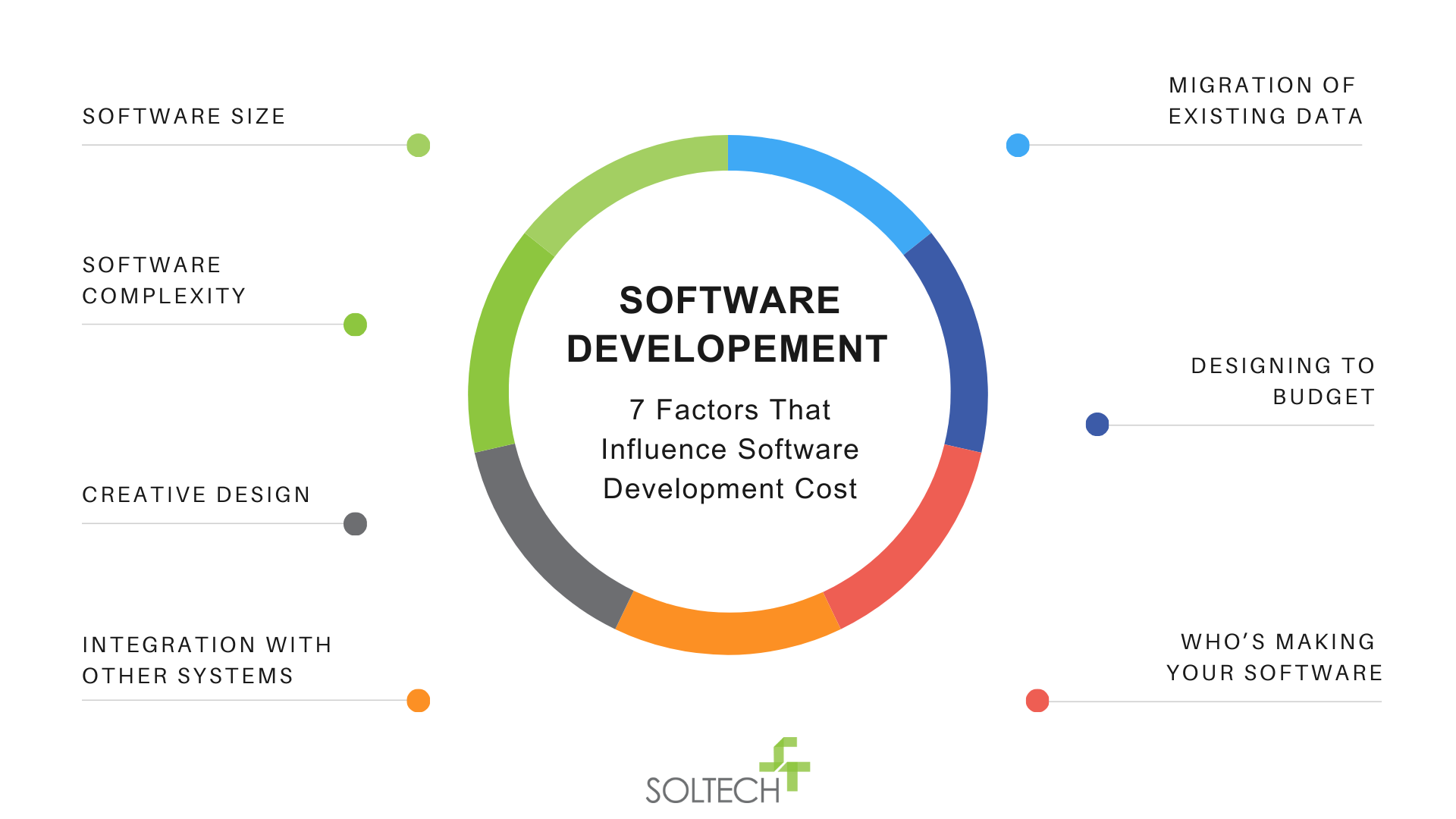
How Much Does Custom Software Development Cost in 2025?
By Thayer Tate
In this article, we will tackle one of the first questions we get asked by our clients: How much do custom software development services cost?
It is a tough question to answer for anyone in the industry, even when you’ve been offering custom software solutions for decades. Why is this? Because there isn’t a universal answer when it comes to custom software development costs. It depends on specifics that can vary greatly from one project to the next.
According to Statista, the development of applications is expected to generate over $195 billion in 2025. As a result, understanding what your project may cost is important to creating a plan for success.
So, how can we create an educated estimate instead? It starts with understanding the general goals you wish to accomplish with your custom software development services. Once we’ve established the goals, we’ll look into seven factors that often have a major influence on the cost of custom software.
Custom Software Development Pricing: The Short Answer
Simply put, the cost of custom software development services varies. In our experience, custom software solutions tend to range from $100,000 to upwards of $400,000 in price, depending on the size of the scope. Small apps may run between $100,000-$200,000, while medium-sized apps may fall in the $200,000-$400,000 range. It’s only large and enterprise-grade applications that typically cost upwards of $400,000.
Because there are many types of software, understanding the true scope of your project is crucial to estimating the cost. A custom software solution could be anything from a calculator on your phone to a full enterprise billing system that supports millions of users. No two custom-built applications are the same.
To better understand where your project may fall, consider the top seven factors that impact a project’s cost the most.
How Much Does Custom Software Development Cost? 7 Key Factors
Understanding what your custom software development services may cost depends on several key factors. Let’s explore them below.
1. Software Size
This one is straightforward. As the number of screens or pages increases, so does the work required in the development process. Custom software engineering services will naturally increase the more complex your project is.
To calculate how many pages you’ll need to pay for, consider anything that the user sees when they first come to your application. The total number also includes each unique screen behind every button click, link click, or menu click.
Small applications tend to have 10-25 pages. Mid-size applications typically fall between 25-40 pages. Large applications will have 40+.
2. Software Complexity
Complicated logic means more time for coding and testing. Will your application perform a lot of heavy analysis, scoring, or number crunching? Does your company’s secret sauce have a lot of nuances and permutations?
Another factor to consider is the scalability of your software. Think of custom software solutions as a long-term investment in your organization. Strategic planning before and during development could increase the project’s cost.
Complexity also goes hand-in-hand with the quantity of code. While smaller applications consist of a few thousand lines of code, larger software often requires tens of thousands of lines of code to function, with some enterprise-scale software requiring upwards of 100,000 lines of code. This could impact the timeline, resulting in a higher cost.
3. Creative Design

This is where you get to select your fonts, color palettes, and images as well as have custom illustrations and animations made to give your application some sizzle.
When thinking about how much your customer software development will cost, you can compare this step to decorating your house. There are extravagant design options, nice options, and anything in between.
So, how much will you need to budget for this step? Because design fees could represent 15-25% of the total cost, you’ll want to keep at least $15,000-30,000 reserved for this step.
4. Integration With Other Systems
Integrating with external software introduces a lot of unknown variables into the equation. You don’t know how well the other system lets information in or out, and what hoops you have to jump through to make these integrations reliable.
Sometimes, the integrations are effortless. In other cases, they are extremely difficult. Typical integrations like payment providers, such as PayPal or Authorize.Net, are extremely easy to perform. Others, such as lesser-known systems, could be tougher, increasing the cost of your custom software development services.
5. Migration of Existing Data
Do you have data in an existing system that needs to go into your new application? Assuming it is more than you can feasibly type in by hand, then you will need migration. Data migration is nothing more than custom scripts that take data out of your old system, dust it off, and reshape it so it can fit into your new system.
The steps of the process are fairly straightforward. However, this will add time and cost to your custom software development services.
6. Who’s Making Your Software
The primary cost of your software solution is the wages of the software engineers, developers, and designers who are creating your software from scratch. Because wages differ based on country, this is something to consider when planning your custom software engineering services.
For United States-based developers, hourly rates can range between $50-250+, depending on experience level. If you’re trying to cut costs, developers in regions such as Eastern Europe, Asia, or India could offer lower rates from $20-80 an hour.
Despite varying costs, U.S.-based developers tend to be the top choice for U.S.-based organizations. This is because of similar time zones, no language barriers, and their ability to work on-site.
7. Designing to Budget
Similar to building a house, software can be designed to fit a certain budget. You may want a butler’s pantry and a finished basement as part of a new home. However, if those luxuries don’t align with your available funds, then it makes sense to exclude them from the design first.
Once the initial design and cost estimate are complete, certain features can be added or removed to hit your target number. Let’s say your budget for custom software development services falls between $100,000-400,000. If you’re looking to add on a $15,000 item, chances are it can be designed into your budget.

Frequently Asked Questions:
Is custom software expensive?
Custom software development services can be a costly investment. However, there are many ways to estimate your costs to fit your budget.
How much does it cost to build software for a small business?
The cost of building software for a small business can vary significantly depending on several factors, including the complexity of the software, the features required, and the development approach. On average, small businesses often opt for smaller software solutions, which generally fall within the price range of $75,000 to $100,000. However, this is a base estimate and can increase if more specialized or complex features are added.
How much does it cost to build custom enterprise-level software?
Custom enterprise software can cost on average $400,000 or more in 2025, depending on the scope. This is because these types of applications tend to have massive scopes.
Why is custom software more expensive than licensing an existing software?
Custom software solutions tend to be more expensive than licensing existing software primarily due to the individualized development process they require. This process involves a team of designers, developers, project managers, and testers, all working to create a solution tailored to specific business needs. The bespoke nature of this development is both labor-intensive and time-consuming, leading to higher overall costs.
The Checklist for Estimating Custom Software Solutions Costs
Before you begin developing your software app, your thoughts and ideas should be clarified and written down so they can be consistently and easily shared and understood. To help you get started on the right foot, we have created a checklist that helps you answer all of the important questions. Grab a copy of that checklist below and share it with your team!
Thayer Tate
Chief Technology Officer Thayer is the Chief Technology Officer at SOLTECH, bringing over 20 years of experience in technology and consulting to his role. Throughout his career, Thayer has focused on successfully implementing and delivering projects of all sizes. He began his journey in the technology industry with renowned consulting firms like PricewaterhouseCoopers and IBM, where he gained valuable insights into handling complex challenges faced by large enterprises and developed detailed implementation methodologies.
Thayer is the Chief Technology Officer at SOLTECH, bringing over 20 years of experience in technology and consulting to his role. Throughout his career, Thayer has focused on successfully implementing and delivering projects of all sizes. He began his journey in the technology industry with renowned consulting firms like PricewaterhouseCoopers and IBM, where he gained valuable insights into handling complex challenges faced by large enterprises and developed detailed implementation methodologies.
Thayer’s expertise expanded as he obtained his Project Management Professional (PMP) certification and joined SOLTECH, an Atlanta-based technology firm specializing in custom software development, Technology Consulting and IT staffing. During his tenure at SOLTECH, Thayer honed his skills by managing the design and development of numerous projects, eventually assuming executive responsibility for leading the technical direction of SOLTECH’s software solutions.
As a thought leader and industry expert, Thayer writes articles on technology strategy and planning, software development, project implementation, and technology integration. Thayer’s aim is to empower readers with practical insights and actionable advice based on his extensive experience.



